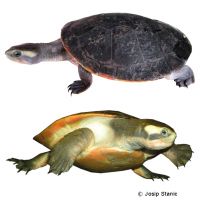Red-bellied Short-necked Turtle (Emydura subglobosa)
| Red-bellied Short-necked Turtle Emydura subglobosa | |
|---|---|
| Name | Red-bellied Short-necked Turtle |
| Name Lat. | Emydura subglobosa |
| Synonym | Emydura albertisii |
| Family | Austro-American Sideneck Turtles |
| Family lat. | Chelidae |
| Order | Turtles |
| Order lat. | Testudines |
| Origin | Australia |
| Habitat | Rivers, lakes |
| Diet | Fish, crayfish, insects |
| Humidity | 60-80 % |
| Behavior | Semi-aggressive |
| Keeping | Individual, pair, group |
| Care Level | Moderate |
| Reproduction | Oviparous |
| Housing | Aquaterrarium |
| Life Span | 20 years |
| Protection | No |
| Metric Units | |
| Size | 25 cm |
| Temperature | 25-28 °C |
| Temperature Local | 35-40 °C |
| Housing Size | 150 x 60 x 60 cm |
| US Units | |
| Size | 9.8" |
| Temperature | 77-82 °F |
| Temperature Local | 95-104 °F |
| Housing Size | 60" x 25" x 25" |
Distribution and habitat
The diurnal red-bellied pointed-headed turtles are widespread in northern Australia on Cape York Peninsula and in New Guinea and some surrounding islands. There they live in slow-flowing waters and lakes as well as ponds with dense vegetation and in heavily weedy swamp areas.
Maintenance
Minimum dimensions for the aquaterrarium, according to the size and number of animals
| floor space for 1-2 animals: 5PL x 2,5PL (L x W) | Water level: 2PB |
The carapace length (PL) and carapace width (PB) is measured on the largest animal. For each additional animal, increase the footprint by 10%, and for the 5th animal and larger, increase the footprint by 20%. We recommend an aquaterrarium of e.g. L 150 x W 60 x H 60 cm which should be placed in a quiet and vibration-free place.
The water part, about 30 cm deep, with soft, muddy substrate, should be structured with roots, aquatic plants and larger stones (visibility barriers and hiding places), some of which reach the water surface. In addition, they need a small, sandy land part with plants and roots as well as sunny spots. To maintain water quality, a powerful filter with low flow and frequent water changes are recommended
| Water Temp | lighting | Sunny | |
| Summer | 25-28 °C | 12-14 hrs. | 35-40 °C |
| winter (2-3 months) | 22-25 °C | 10-12 hrs |
They need high light intensity and daily UV irradiation as well as sunny places with radiant heat.
Diet
They feed mainly on animal food. The food supply consists of frozen food, such as aquatic insects, shrimps, crayfish, smelts, mussel and fish meat, etc., supplemented with commercially available dry food for aquatic turtles. In addition, they occasionally require plant food, which is accepted differently from individual to individual, such as lettuce, dandelion, endive and aquatic plants (e.g. waterweed) as well as fruit (banana). Adult animals should be offered food twice a week. It is important to regularly add minerals and vitamins
A varied diet promotes health and prevents deficiency symptoms.
Reproduction and breeding
The males have a concave ventral carapace (plastron) and a much longer tail. Mating occurs year-round, but the end of the rainy season is preferred. Egg-laying occurs several times a year. The female buries her eggs, a maximum of 15 per clutch near water. The incubation period is 45-60 days at an average of 29 °C
Life expectancy can be over 20 years.
Important
They need a large aquaterrarium and should not be socialized with other aquatic turtles. Although the animals are very compatible with each other, care must be taken that low ranking animals receive sufficient food
Red-bellied pointed-head turtles are almost exclusively aquatic. Occasionally, egg laying occurs underwater in mud. Embryonic development in the egg does not begin until the body of water has dried up
Particular attention should be paid to good water quality.
The terrarium must have good ventilation without drafts and meet the species-specific needs. Measuring devices such as thermometers, hygrometers, etc. are necessary. The lighting has to correspond to the species-specific day-night rhythm and has to be placed in such a way that the animals cannot injure themselves. The terrarium should be locked in such a way that neither unauthorized persons can open it nor the animals can escape. Contamination must be removed regularly
Further literature can be found in your pet store.
References
Text: Christian Sänger; Image: Josip Stanic
Source: BMELV (1997): Mindestanforderungen an die Haltung von Reptilien; ENGELMANN (2006): Zootierhaltung - Tiere in menschlicher Obhut: Reptilien und Amphibien, Harri Deutsch Verlag
- Gemäß § 21 Abs. 5 Tierschutzgesetz idgF
